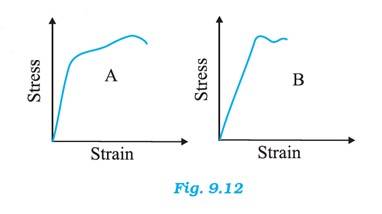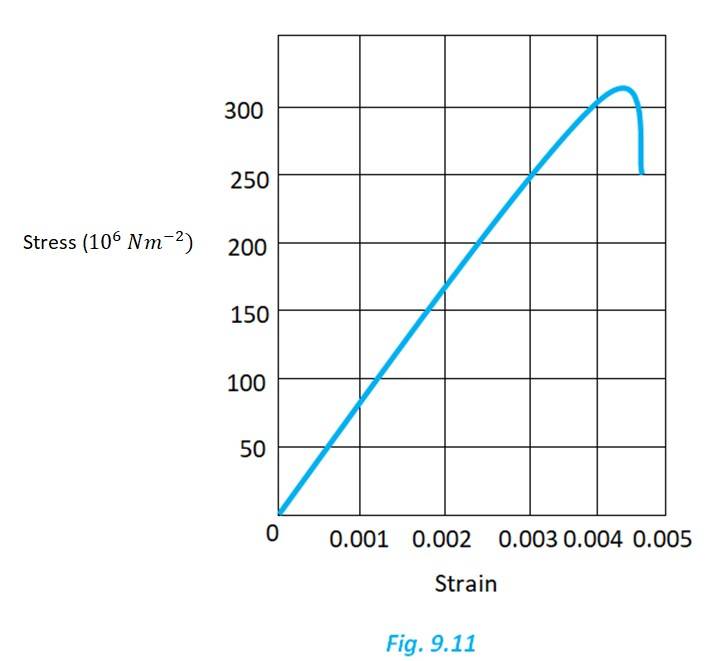Class 11th
Get insights from 8k questions on Class 11th, answered by students, alumni, and experts. You may also ask and answer any question you like about Class 11th
Follow Ask QuestionQuestions
Discussions
Active Users
Followers
New answer posted
6 months agoContributor-Level 10
Area of cross-section, A = 15.2 mm = 15.2
Force, F = 44500 N
Stress, F/A = (44500/ N/
Modulus of elasticity, = Stress / Strains, Strains = Stress /
For copper, = 42
Strains = (44500/ 42 = 3.65
New answer posted
6 months agoContributor-Level 10
Mass of the big structure, M = 50000 kg = 50000 = 4.9 N
Inner radius of the column, r = 30 cm = 0.3 m
Outer radius of the column, R = 60 cm = 0.6 m
Young's modulus of steel, Y = 2 Pa
Total force exerted on 4 columns, F = 4.9 N
Force exerted on single column, f = F/4 = 1.225 N
Cross sectional area of each column, A = = = 0.848
Stress in each column = f/A
Young's modulus, Y = Stress / Strain, Strain = Stress / Y = f/ (A = m
New answer posted
6 months agoContributor-Level 10
Edge of the aluminium cube, L = 10 cm = 0.1 m, Area A = 0.01
Mass attached, m = 100 kg = 100 9.8 = 980 N = Applied force F
Shear modulus = 25 GPa = 25
Shear modulus = Shear stress / Shear strain = , = = 3.92
New answer posted
6 months agoContributor-Level 10
Diameter of wires, d = 0.25 cm, radius, r = 0.125 cm
Cross-sectional area, = = = 4.908
Length of the steel wire, , length of the brass wire,
Change in length of the steel wire Change in length of the copper wire
Total force exerted on the steel wire, = ( 4+6) kg = 10 kg = 98 N
Young's modulus of steel , = = 2.0 Pa
= = 1.497 m
Similarly for brass wire, = 6 kg = 58.8 N, =
= = 1.316 m
New answer posted
6 months agoContributor-Level 10
For a given stress, the strain in rubber is more than it is in steel, hence the Young's modulus of rubber is lesser than in steel. So the statement is False.
Shear modulus is the ratio of the applied stress to the change in the shape of a body. The stretching of a coil changes its shape. Hence, shear modulus of elasticity is involved in this process.
= 2.2
New answer posted
6 months agoContributor-Level 10
Material A has greater Young's modulus.
Material A is the strongest as it can withstand more strain than material B without fracture.
New answer posted
6 months agoContributor-Level 10
From the given graph, for the value stress 150 N/ , the strain is 0.002
Young's modulus = = 7.5 N/
Yield strength is the maxium strength the material can withstand in elastic limit. From the graph, the yield strength is 300 or 3
New answer posted
6 months agoContributor-Level 10
Length of the steel wire, = 4.7 m
Area of cross-section of the steel wire, = 3.0 m2
Length of the copper wire, = 3.5 m
Area of cross-section of the copper wire, = 4.0 m2
Change in length,
Let the force applied = F
Young's modulus in steel wire,
= ….(1)
Young's modulus in copper wire,
= …….(2)
The ratio of Young's modulus
= = = =
New answer posted
6 months agoContributor-Level 10
32.
Since P (a, b) is the mid-point of the line segment say AB with points A (0, y) and B (x, 0) we can write,
So, the equation of line with x and y intercept 2a and 2b using intercept form is
Hence, proved
New answer posted
6 months agoContributor-Level 10
31.
Assuming the price per litre say P in x-axis and the corresponding demand say D in y-axis, we have two point (14, 980) and (16, 1220) in xy plane. Then the points (P, D) will satisfy the equation.

Which is the required relation
Where P = 17, we have
D = 120 * 17 – 700
D = 1340
Hence, the owner can sell 1340 litres of milk weekly at 17/litre
Taking an Exam? Selecting a College?
Get authentic answers from experts, students and alumni that you won't find anywhere else
Sign Up on ShikshaOn Shiksha, get access to
- 65k Colleges
- 1.2k Exams
- 679k Reviews
- 1800k Answers



